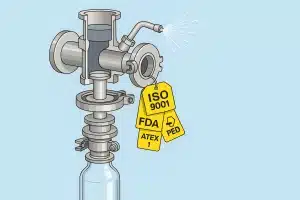Sample valves are crucial components in a variety of industries, providing an essential function in the sampling process. These valves are typically used in systems where accurate and representative samples of fluids need to be obtained for analysis. Whether in the food and beverage industry or in pharmaceutical and chemical processes, sample valves play a pivotal role in ensuring quality control and operational efficiency. This article delves into the different types of sample valves, their applications, and why stainless steel is often the material of choice for their construction.
What is a Sample Valve and How Does it Work?
Definition and Purpose of Sample Valves
A sample valve is a type of valve specifically designed to extract a representative sample of fluid from a process line or tank. These valves are used to collect samples for quality control, testing, and analysis, ensuring that the sample reflects the true nature of the fluid within the system. Sampling valves are also used to minimize contamination and maintain the integrity of the sample, which is critical in industries like pharmaceuticals and food and beverage where sterility is paramount.
Principles of Operation
The operation of a sample valve involves opening a pathway for fluid flow through the valve, allowing a controlled amount of the fluid to be drawn out. This might involve mechanical action, such as turning a handle to move a plug or stem, or automation through pneumatic or solenoid actuators. The design and operation ensure minimal pressure drop and maintain the desired flow rate while preventing contamination of the sample. This precise control is essential for obtaining consistent and reliable samples.
Key Components of a Sample Valve
The key components of a sample valve include the valve body, stem, and actuator. The valve body is typically made from materials like stainless steel, which offers durability and resistance to corrosion. The stem is responsible for opening and closing the valve, while the actuator, which can be manually operated or automated, controls the movement of the stem. Seals are also a critical component, ensuring a tight closure to prevent leaks and maintain sterile conditions.
What are the Common Types of Sample Valves?
Ball Valves vs. Butterfly Valves
Among the different types of sample valves, ball valves and butterfly valves are particularly common. A ball valve features a spherical plug with a hole through the center, allowing fluid to flow when the valve is open. These valves provide excellent sealing capabilities and are ideal for applications requiring precise flow control. On the other hand, butterfly valves have a disk mounted on a rotating shaft and are also used for their quick operation and suitability for flow regulation in large pipes.
Sanitary Sample Valves
Sanitary sample valves are designed to meet stringent hygiene standards, making them ideal for use in the food and beverage and pharmaceutical industries. These valves are typically constructed from stainless steel to prevent contamination and are designed to be easily cleaned and sterilized. Sanitary valves often feature smooth surfaces and angles that minimize areas where bacteria could accumulate, ensuring the highest level of cleanliness.
Modular and Mechanical Sample Valves
Modular sample valves offer flexibility in installation and can be configured to meet specific process requirements. They allow for easy integration with existing systems and are versatile in their applications. Mechanical sample valves, on the other hand, rely on manual operation, providing a simple and reliable solution for sampling in less automated environments. Both types can be equipped with various seals and materials to handle different fluid characteristics and process conditions.
How to Choose the Right Sample Valve for Your Reactor?
Considerations for Selecting a Valve
Choosing the right sample valve for a reactor involves considering several factors, such as the type of fluid being sampled, the required flow rate, and the system’s pressure and temperature conditions. The valve’s compatibility with the reactor’s material and design is also crucial. Operators must ensure that the selected valve can withstand the chemical and physical properties of the fluid to prevent degradation and ensure long-term functionality.
Importance of Seal and Material
The seal and material of a sample valve significantly impact its performance and durability. Stainless steel is often preferred for its corrosion resistance and strength, especially in harsh chemical environments. Seals must be chosen based on their compatibility with the fluid and the operating temperature and pressure. A well-chosen seal ensures the valve’s reliability and effectiveness in preventing leaks and maintaining sample integrity.
Application-Specific Requirements
Different applications may have unique requirements that influence the choice of sample valve. For instance, in a sterile pharmaceutical environment, valves must be designed to meet stringent sanitary standards. In contrast, a chemical processing plant might prioritize valves that can handle corrosive fluids and high temperatures. Understanding the specific needs of the application is critical to selecting a valve that offers optimal performance and longevity.
Why is Stainless Steel Preferred in Sample Valve Construction?
Advantages of Stainless Steel in Valves
Stainless steel is highly regarded in sample valve construction due to its excellent resistance to corrosion and ability to withstand extreme temperatures and pressures. This makes it an ideal choice for industries where the integrity of the valve is critical. Stainless steel’s non-reactive nature ensures that it does not compromise the purity of the sample, which is especially important in food, beverage, and pharmaceutical applications.
Durability and Sanitary Benefits
The durability of stainless steel sample valves ensures a long service life, reducing the need for frequent replacements and maintenance. Its smooth, non-porous surface is easy to clean and sterilize, making it a preferred choice for sanitary applications. This material’s strength and resilience also contribute to the valve’s ability to maintain a tight seal, preventing contamination and ensuring the safety and quality of the samples collected.
Impact on Flow and Performance
Stainless steel’s impact on the flow and performance of sample valves is significant. It provides a robust structure that can handle high flow rates without distortion, ensuring consistent and reliable sampling. Its thermal and chemical stability means it can maintain performance in a wide range of operating conditions, which is crucial for maintaining process efficiency and sample accuracy in various industries.
How are Sample Valves Used in the Beverage Industry?
Applications in Beverage Processing
In the beverage industry, sample valves are integral to the processing and quality control of products. These valves allow for the extraction of samples from different stages of production, such as fermentation tanks or mixing vessels, ensuring that the beverage meets the desired taste and quality standards. By providing a way to monitor the process, sample valves help maintain consistency and optimize production efficiency.
Ensuring Quality and Safety
Sample valves play a critical role in ensuring the quality and safety of beverages. By allowing operators to take samples for microbial testing and chemical analysis, these valves help detect potential issues early in the production process. This proactive approach minimizes the risk of contamination and ensures that the final product is safe for consumption, thus protecting consumer health and brand reputation.
Integration with Pipe Systems
Integration of sample valves with pipe systems is crucial in the beverage industry, where seamless operation and cleanliness are paramount. These valves are often installed at strategic points in the piping to facilitate easy sampling without disrupting the flow. Their design allows them to be easily incorporated into existing systems, ensuring that they do not impede the overall process while providing accurate and reliable samples for analysis.
Conclusion
Sample valves play an indispensable role in modern industrial processes, from beverage production to pharmaceutical manufacturing. Their ability to provide reliable, contamination-free samples makes them crucial for quality control and process optimization. When selecting a sample valve, consider your specific application requirements, fluid properties, and operating conditions. Stainless steel construction, combined with appropriate seals and proper integration, ensures these valves deliver consistent performance and maintain sample integrity. As industries continue to emphasize quality control and efficiency, sample valves remain essential tools for maintaining product excellence and operational success.






